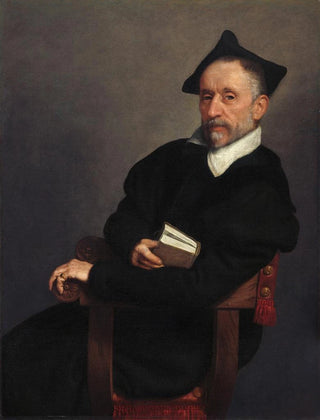Art print | Titian's Schoolmaster - Giovanni Battista Moroni


View from behind

Frame (optional)
In the fascinating world of Renaissance painting, "Le maître d'école de Titien" by Giovanni Battista Moroni stands out for its profound humanism and its ability to capture the very essence of its characters. This iconic work, created in the 16th century, does not merely depict a schoolmaster but embodies a reflection on knowledge, education, and the transmission of wisdom. Through the penetrating gaze of the central figure, Moroni invites us to explore the fundamental role of the teacher in the society of his time. The composition, rich in detail and emotion, immerses us in a silent dialogue between the master and his students, revealing the power of education as a vehicle for social transformation.
Style and uniqueness of the work
Moroni's style is characterized by striking realism and meticulous attention to detail. In "Le maître d'école de Titien," the artist manages to create an intimate atmosphere where each element of the canvas contributes to the visual storytelling. The textures of the clothing, the play of light on the master's face, and the depth of shadows are all techniques that demonstrate his skill. Moroni also employs a palette of subdued yet rich colors, which emphasize the dignity of the main character. This chromatic choice reflects a desire to highlight the intellectual and moral character of the master, while underscoring the seriousness of his educational mission. The posture of the figure, both firm and benevolent, evokes a respected authority, and his gaze, both direct and contemplative, seems to invite the viewer to reflect on the nature of teaching and learning.
The artist and his influence
Giovanni Battista Moroni, often regarded as one of the masters of Renaissance portraiture, distinguished himself through his ability to combine impeccable technique with human sensitivity. Trained in the workshop of Giovanni Bellini and influenced by Titian, Moroni developed a style that is uniquely his own, blending realism with psychological depth. His work is marked by a faithful representation of individuals, whether noble or simple peasants, demonstrating a democratic approach to art. Moroni thus contributed to redefining

Matte finish

View from behind

Frame (optional)
In the fascinating world of Renaissance painting, "Le maître d'école de Titien" by Giovanni Battista Moroni stands out for its profound humanism and its ability to capture the very essence of its characters. This iconic work, created in the 16th century, does not merely depict a schoolmaster but embodies a reflection on knowledge, education, and the transmission of wisdom. Through the penetrating gaze of the central figure, Moroni invites us to explore the fundamental role of the teacher in the society of his time. The composition, rich in detail and emotion, immerses us in a silent dialogue between the master and his students, revealing the power of education as a vehicle for social transformation.
Style and uniqueness of the work
Moroni's style is characterized by striking realism and meticulous attention to detail. In "Le maître d'école de Titien," the artist manages to create an intimate atmosphere where each element of the canvas contributes to the visual storytelling. The textures of the clothing, the play of light on the master's face, and the depth of shadows are all techniques that demonstrate his skill. Moroni also employs a palette of subdued yet rich colors, which emphasize the dignity of the main character. This chromatic choice reflects a desire to highlight the intellectual and moral character of the master, while underscoring the seriousness of his educational mission. The posture of the figure, both firm and benevolent, evokes a respected authority, and his gaze, both direct and contemplative, seems to invite the viewer to reflect on the nature of teaching and learning.
The artist and his influence
Giovanni Battista Moroni, often regarded as one of the masters of Renaissance portraiture, distinguished himself through his ability to combine impeccable technique with human sensitivity. Trained in the workshop of Giovanni Bellini and influenced by Titian, Moroni developed a style that is uniquely his own, blending realism with psychological depth. His work is marked by a faithful representation of individuals, whether noble or simple peasants, demonstrating a democratic approach to art. Moroni thus contributed to redefining






